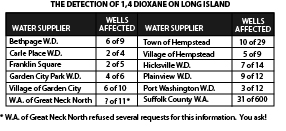This past July, the state Department of Health proposed drinking water standards (a.k.a. maximum contaminant levels or MCLs) for three emerging contaminants in drinking water- PFOA, PFOS and 1,4 Dioxane.
The public comment period closed on Sept. 22. While many advocacy organizations asked for stronger standards, the water supply community was letting their needs be known to both regulators and elected officials.
In Nassau County, the legislative committee on Planning, Development and Environment, chaired by Legislator Laura Schaefer, and accompanied by committee members, held a hearing on the topic of 1,4 Dioxane on July 29 in Mineola.
At the hearing, numerous water suppliers, a consultant to water systems, the Nassau Health Department, and an advocacy organization (Citizens Campaign for the Environment), were invited to provide specifically on the impact and issues around testing and treating for 1,4 Dioxane. Some interesting facts came out during the testimony.
The impact on some of the water systems in Nassau County was summarized. Some of the water suppliers affected by 1,4 Dioxane and the number of wells involved is shown in Table 1.
Drinking Water Treatment
The treatment technology that has been approved to remove 1,4 Dioxane is known as Advanced Oxidation Process. This technology has not been previously used for drinking water treatment on Long Island.
To date, two AOP systems have been installed and approved: Bethpage Water District and the Suffolk County Water Authority. The Nassau County Health Department has received proposals to install 13 AOP systems so far and expects to receive 50 more before the end of 2019. It may take 2 – 3 years to get a system installed, fully approved and operational. There is funding available from NY State to help defray the cost of the AOP system, which can be several million dollars each.
A special fund for 1,4 Dioxane and PFAS treatment of $200 million is available to water suppliers, statewide. Additional money is available to water systems through the NYS Clean Water Infrastructure Act (2017) that authorized a total of $2.5 billion for water-related projects across the state. Water suppliers need to apply to the state for the grants. As of August 2019, twelve grants have been approved, totaling $42 million. The total funds available are $350 million.
Water Suppliers Want a Delay in Compliance with New Drinking Water Standards
All the water suppliers who spoke agreed that they need more time to come into compliance once new drinking water standards are adopted by the State Department of Health. The proposed MCL for 1,4 Dioxane is 1 part per billion (ppb). Most water suppliers stated that they might have to shut down a significant proportion of their well systems if compliance is required immediately upon adoption of the MCLs.
In addition to closing non-complying wells, the other actions suppliers are considering include:
• Blending high-quality water with contaminated water (this practice is usually prohibited for cancer-causing chemicals in drinking water);
• Sharing water between neighboring water systems through existing water interconnections;
• Deepening contaminated wells into cleaner, deeper parts of the aquifer system (e.g. the Magothy aquifer);
• Constructing new wells where unaffected groundwater can be found; and
• Implementing strict water conservation programs.
Water suppliers vowed they would not provide water that violates the new standards. However, they were uncertain what they would do if a majority of their water supply wells were shut down. Hicksville, for example, could lose 70 percent of their water supply.
Various proposals to delay implementation of the new MCLs were discussed. A delay of 2 to 4 years was frequently suggested. One proposal suggested a phased-in MCL that had 3 stages: a 10 ppb MCL beginning in 2020; a 3.5 ppb MCL beginning in 2023; and a 1.0 ppb MCL staring in 2026.
The Source of 1,4 Dioxane
Although it is true that 1,4 Dioxane is found in numerous consumer products, the most realistic source of 1,4 Dioxane for Nassau County is the many state and federal superfund sites in the county. 1,4 Dioxane was used as an ingredient in the manufacture of many volatile organic compounds (VOCs) that are a major pollutant in the groundwater plumes at the 150+ sites in Nassau County. So, where high levels of VOCs are in the groundwater, 1,4 Dioxane is likely to be there too.
The most extreme example of this relationship is the Navy-Grumman plume in Bethpage. Over 600 samples of groundwater from the plume were tested. High levels of 1,4 Dioxane were found in 306 out of 634 samples. The levels of 1,4 Dioxane ranged from 0.46 ppb to 190 ppb.




